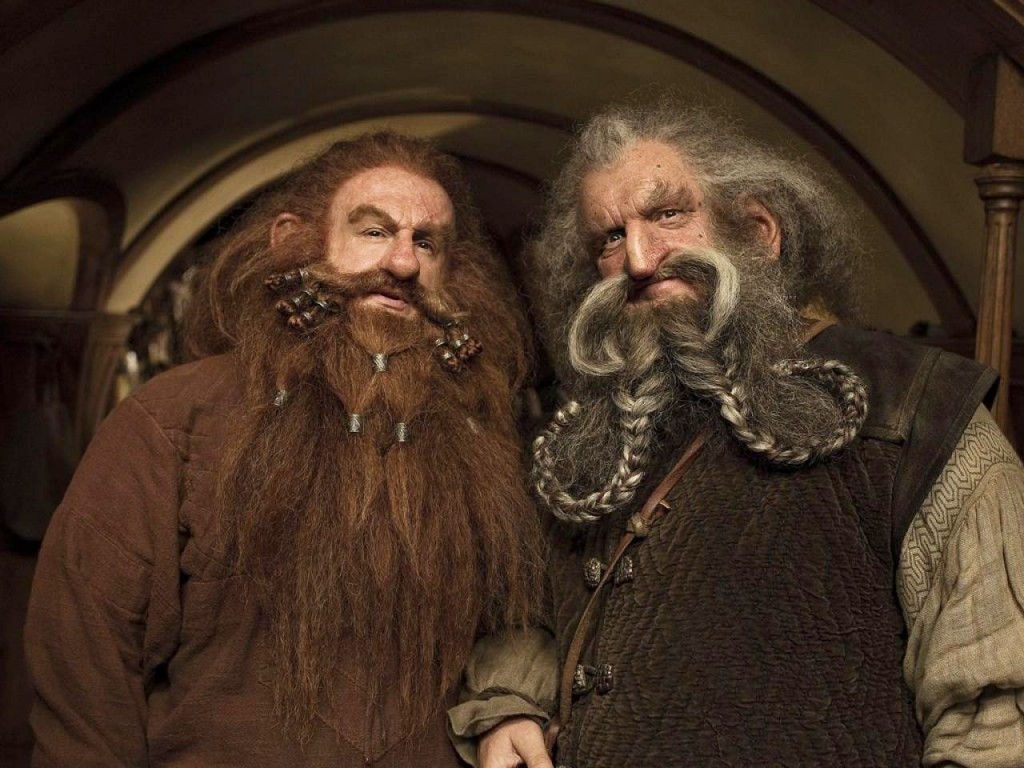 Welcome to our weekly live webcast — known as TORn TUESDAY — a unique show format where you can come into the chat and participate live. We are now on the 4th part of our ongoing series of discussions on the History of the Dwarves who undertake the Quest of Erebor. Today we switch gears to discuss OIN and GLOIN (father of our Fellowship member Gimli) and learn about the great fate tying up these characters in the House of Durin’s Line! Bring your questions and join us LIVE for what will be a very illuminating discussion of dark Dwarven secrets! We have *JUST* confirmed that our actors playing these roles have been whisked away to the studios in Wellington, where Peter Jackson has commenced new shoots for The Hobbit: The Desolation of Smaug!
Welcome to our weekly live webcast — known as TORn TUESDAY — a unique show format where you can come into the chat and participate live. We are now on the 4th part of our ongoing series of discussions on the History of the Dwarves who undertake the Quest of Erebor. Today we switch gears to discuss OIN and GLOIN (father of our Fellowship member Gimli) and learn about the great fate tying up these characters in the House of Durin’s Line! Bring your questions and join us LIVE for what will be a very illuminating discussion of dark Dwarven secrets! We have *JUST* confirmed that our actors playing these roles have been whisked away to the studios in Wellington, where Peter Jackson has commenced new shoots for The Hobbit: The Desolation of Smaug!
Join us for TORn TUESDAY every week at 5:00PM Pacific: brought to you by host Clifford “Quickbeam” Broadway and producer Justin “I Haven’t Read The Books Yet” Sewell — as we discuss the unique characteristics of each Dwarf. We shall learn how they fit into the larger history of Tolkien’s legends — and what Peter Jackson & WETA did to help us distinguish these rough and tumble travelers from each other (using more than just colored hoods). Our innovative live show includes worldwide fans who join us on the Live Event page with a built-in IRC chat (affectionately known as Barliman’s Chat room). Be part of the fun and mischief every week as we broadcast *live* from Meltdown Comics in the heart of Hollywood, U.S.A.!
NEXT WEEK: Bifur, Bofur….. and Bombur, for real this time!
——————————————————————-
Follow Cliff ‘Quickbeam’ Broadway on Twitter: @quickbeam2000
Posted in:
Share:

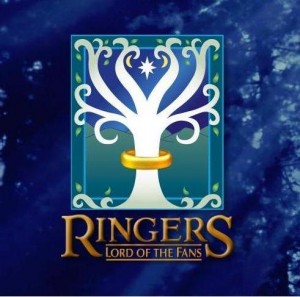 In 2005 we premiered our very own documentary feature film RINGERS: Lord of the Fans at the Slamdance Film Festival in Park City, where it was quickly snapped up by Sony Pictures Home Entertainment for worldwide distribution on DVD and cable! It is finally available on iTunes after 7 years of hopeful waiting… you can also find it on Amazon Instant and on VUDU.
In 2005 we premiered our very own documentary feature film RINGERS: Lord of the Fans at the Slamdance Film Festival in Park City, where it was quickly snapped up by Sony Pictures Home Entertainment for worldwide distribution on DVD and cable! It is finally available on iTunes after 7 years of hopeful waiting… you can also find it on Amazon Instant and on VUDU.
What a fun movie! Dominic Monaghan (Meriadoc Brandybuck) came on board to be our wonderful narrator! Actually this film is a time capsule of many decades of pop culture history — giving us the full story on how the world has embraced Tolkien’s masterpiece THE LORD OF THE RINGS over 50 years and more!
Winner of the Outstanding Achievement Award at the Newport Beach Film Festival, RINGERS was produced in association with TheOneRing.net — this remarkable little film was forged BY fans and FOR fans, just like our website, with the production/writing talent of Clifford “Quickbeam” Broadway (who hosts TORn TUESDAY every week), Jeff Marchelletta, and supercool director Carlene Cordova. It was executive produced by X-Men/Transformers guru Tom DeSanto.
With a wonderful rock-driven score and detailing all the outpouring of love bestowed on Tolkien over many generations, this film is a must-have for your digital collection! Get it on iTunes now for only $9.99!
From the original Sony Press Release:
“RINGERS is comprehensive, entertaining and informative pop culture history.”
– The Toronto Star
“…Will always be a salient part of ‘LORD OF THE RINGS’ history…
See it, absorb it, love it.” – FilmThreat
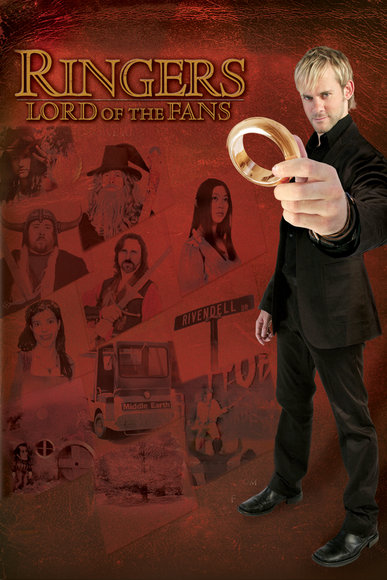 Winner of “Outstanding Achievement” Award at the
Winner of “Outstanding Achievement” Award at the
Newport Beach Film Festival
RINGERS: LORD OF THE FANS
FASCINATING DOCUMENTARY CAPTURES THE HISTORY, INFLUENCE AND PHENOMENON THAT IS LORD OF THE RINGS
CULVER CITY, Calif. (September 12, 2005) – Sony invites you to return to the Shire with the release of the feature-length documentary RINGERS: LORD OF THE FANS, direct to DVD. In association with the popular fan-site TheOneRing.net, Carlene Cordova produced, directed and wrote this award-winning film with executive producer Tom DeSanto(X-Men, X2: X-Men United and Transformers), which charts the incredible influence and ripple-effect that Lord of the Rings has had on worldwide pop culture over the past five decades. Whether you are a fan or first timer, critics agree, RINGERS, stands as the most comprehensive film documenting the ongoing impact of J.R.R. Tolkien’s literary achievement.
Dominic Monaghan (star of ABC’s Lost and the Academy Award® winning Lord of the Rings trilogy) narrates the documentary as it looks behind the curtain between Lord of the Rings and how it inspired so many artists of different mediums. The film moves beyond “cult classic” and through different generations unearthing the way legendary rock musicians, filmmakers, professors, actors and authors all unite under the banner of ‘Ringer.’ Interviewees included in the film are Lord of the Rings trilogy filmmaker Peter Jackson as well as Elijah Wood, Viggo Mortensen, Ian McKellen, Sean Astin and David Carradine. Infused with a dynamic rock-driven score, irreverent cut-out animation (á la Terry Gilliam), and a centerpiece audience sing-a-long, RINGERS is a genre-busting documentary that shows how a single literary work continues to spark the minds and hearts of millions.
RINGERS continues the momentum of the motion picture trilogy Lord of the Rings, a winner of 17 Academy Awards including Best Picture and Best Director for Peter Jackson, who made history as the first person to direct three major feature films simultaneously.
From the official synopsis:
Ringers: Lord of the Fans is a feature-length documentary that reveals the ongoing cultural phenomenon created by The Lord of the Rings. Very funny and often moving, Ringers shows the hidden power behind Tolkien’s books — and how after 50 years a single literary work continues to spark the minds and hearts of millions, across cultures and across time.
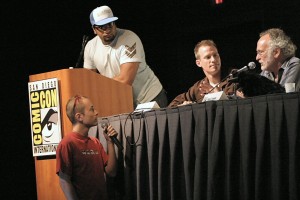 Shot with groundbreaking new digital technology in 24P, Ringers explores the real foundations of Middle-earth; a community of true fans who share a common bond. Moving beyond “cult classic” and over several different generations, the film unearths academics, musicians, authors, filmmakers, and a plethora of pop junkies — the people gathered under the banner of ‘Ringer.’ From the hippie counter-culture to the electronic age; from the Bakshi animated film to Jackson’s epic trilogy; this documentary brings together extensive footage from across the globe. With units in Los Angeles, San Diego, Atlanta, Salt Lake City, Bonn, Germany, Wellington, New Zealand, and Oxford, England, our cameras capture the most fascinating “Ringers” and Lord of the Rings events.
Shot with groundbreaking new digital technology in 24P, Ringers explores the real foundations of Middle-earth; a community of true fans who share a common bond. Moving beyond “cult classic” and over several different generations, the film unearths academics, musicians, authors, filmmakers, and a plethora of pop junkies — the people gathered under the banner of ‘Ringer.’ From the hippie counter-culture to the electronic age; from the Bakshi animated film to Jackson’s epic trilogy; this documentary brings together extensive footage from across the globe. With units in Los Angeles, San Diego, Atlanta, Salt Lake City, Bonn, Germany, Wellington, New Zealand, and Oxford, England, our cameras capture the most fascinating “Ringers” and Lord of the Rings events.
What began as the private amusement of a tweedy Oxford professor has now become a new mythology for the 21st century. Ringers: Lord of the Fans shows how an adventure story published in 1954 has had dynamic ripple-effects through Western pop-culture. Ringers carefully pulls away the veil between Tolkien’s book and the creations of art, music, and community that have been inspired by it.
Check out the official trailer here:
Posted in:
Share:

As TORn readers will no doubt have heard by now, Ray Harryhausen, the man who pioneered stop motion photography and led the way to many of the special effects we take for granted today, died on Tuesday. He was 92. His classic films, such as Jason and the Argonauts and Clash of the Titans, inspired many future movie makers, with their wonderful scenes of monsters and mythical creatures, brought to life by Harryhausen’s brilliant use of stop motion technique. As a teenager, Harryhausen had himself been inspired by the 1933 King Kong; it seems fitting, then, that he in turn became a source of great inspiration for a teenage Peter Jackson, who of course made his own King Kong movie in 2005. USA Today quoted this statement from Peter Jackson: ‘The Lord of the Rings is my Ray Harryhausen movie. Without his lifelong love of his wondrous images and storytelling it would never have been made — not by me, at least.’
You can read more about Ray Harryhausen here. In 2010, BAFTA paid special tribute to Harryhausen in celebration of his 90th birthday. Peter Jackson was a surprise guest, and at the event he showed some of his earliest attempts as a teenage film maker, clearly inspired by Harryhausen’s movies. Jackson’s presentation – and those wonderful, early film clips – can be seen here.
The film industry has lost a legend; RIP Ray Harryhausen.
Posted in:
Share:

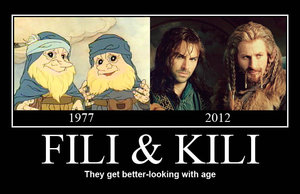 Greetings all! Last week we began the first of a series of webcasts profiling each dwarven member of Thorin’s Company, starting with Balin and Dwalin (who were 1st to arrive at Bilbo’s round green door) and today moving on to discuss the youngest, and in a way almost beardless, Dwarves of the nascent traveling company, Kili and Fili! Join us for TORn TUESDAY every week at 5:00PM Pacific: brought to you by host Clifford “Quickbeam” Broadway and producer Justin “I Haven’t Read The Books Yet” Sewell — as we discuss the unique characteristics of each Dwarf. We shall learn how they fit into the larger history of Tolkien’s legends — and what Peter Jackson & WETA did to help us distinguish these rough and tumble travelers from each other (using more than just colored hoods). Our innovative live show includes worldwide fans who join us on the Live Event page with a built-in IRC chat (affectionately known as Barliman’s Chat room). Be part of the fun and mischief every week as we broadcast *live* from Meltdown Comics in the heart of Hollywood, U.S.A. The show will begin in less than 20 minutes from *now*!
Greetings all! Last week we began the first of a series of webcasts profiling each dwarven member of Thorin’s Company, starting with Balin and Dwalin (who were 1st to arrive at Bilbo’s round green door) and today moving on to discuss the youngest, and in a way almost beardless, Dwarves of the nascent traveling company, Kili and Fili! Join us for TORn TUESDAY every week at 5:00PM Pacific: brought to you by host Clifford “Quickbeam” Broadway and producer Justin “I Haven’t Read The Books Yet” Sewell — as we discuss the unique characteristics of each Dwarf. We shall learn how they fit into the larger history of Tolkien’s legends — and what Peter Jackson & WETA did to help us distinguish these rough and tumble travelers from each other (using more than just colored hoods). Our innovative live show includes worldwide fans who join us on the Live Event page with a built-in IRC chat (affectionately known as Barliman’s Chat room). Be part of the fun and mischief every week as we broadcast *live* from Meltdown Comics in the heart of Hollywood, U.S.A. The show will begin in less than 20 minutes from *now*!
NEXT WEEK: Dori, Nori …… and Ori!
——————————————————————-
Posted in:
Share:

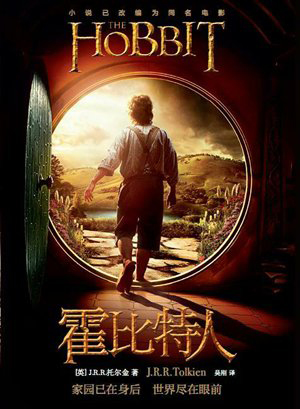 In his first of many articles for our worldwide community, Tedoras, long-time audience participant on our TORn TUESDAY webcast brings us an illuminating discussion on something that fascinates the inner-linguist in us all: taking the very Euro-centric names and words Tolkien invented and reforming them into other languages! How do foreign-language translators deal with Tolkien’s legendarium? Read on for some keen insights! Take it away, Tedoras….
In his first of many articles for our worldwide community, Tedoras, long-time audience participant on our TORn TUESDAY webcast brings us an illuminating discussion on something that fascinates the inner-linguist in us all: taking the very Euro-centric names and words Tolkien invented and reforming them into other languages! How do foreign-language translators deal with Tolkien’s legendarium? Read on for some keen insights! Take it away, Tedoras….
————————————————————————————-
By Tedoras — special to TheOneRing.net
In recent years, and especially following the release of the first installment of The Hobbit films, Latin America and China have both become major sources of Tolkien fandom. While we often associate the works of Tolkien with the English-speaking world, the international nature of modern Ringerdom cannot be ignored. The Spanish and Chinese-speaking markets have undeniably helped in making An Unexpected Journey the fourteenth highest grossing film of all time. An historical challenge with Tolkien’s works, however, is how best to translate them. Whether in film or literature, translators have struggled and debate for years on how translate the names of people and places without losing the original sound and meaning that the Professor clearly intended. The process of de-anglicizing these nouns is further complicated because not only must English-language etymology be considered, but also that of Middle-earth’s many distinct tongues.
In Middle-earth, we find a strong correlation between sound and meaning that is particularly evident in the context of “soft” or “hard/harsh” names. For example, the word “Shire” conjures up visions of a distinctly British pastoral community — in essence, one notes a favorable and pleasant sense simply from reading the word. In contrast, “Dol Guldur” is composed of hard consonants and more guttural vowels which denote a rather negative air. Another popular theme is the use of alliteration; it is no mere coincidence that Bilbo Baggins lives in Bag End. As you will see, the biggest problem in translating proper nouns is deciding whether to maintain the original sound or meaning intended by the author, when often both cannot be kept.
It just so happens that Chinese and Spanish are two languages I study, so, in homage to the large Latin American and Chinese Tolkien-fan base around the world, I have decided to present some translations of proper nouns from The Hobbit. While these translations certainly highlight the many different ways Tolkien’s works can be translated, they also provide some important insight into Middle-earth (and some unintended laughs along the way).
I first present some Spanish translations of proper names.
These translations reflect an effort to keep the original meaning of a word, rather than its sound. However, because of its close relationship with English, Spanish allows for the pronunciation of many words in their original form.
Bilbo Bolsón
This is of course our favorite hobbit, Bilbo Baggins. Interesting here is the translation of the surname. In Spanish, “bolsón” is the augmentative form of “bolsa,” which literally means “bag.” A “bolsón” is simply a large bag or backpack, yet in translation it is used to convey the “bag” in Baggins.
Bardo el Arquero
Bard the Bowman is, in Spanish, literally Bard the Archer. In this case, we note a loss of alliteration in translation. It may seem trivial, but alliteration very much shapes how we view a character. The strong “b” sound in Bard’s English title provides him with a bold, confident aura. In a way, the Spanish version tries to make up for this loss by means of assonance and the repetition of the “o” in Bardo and “Arquero.”
Guille Estrujónez
Bill Huggins is one of our favorite trolls. His surname is of particular interest; in the translation, we find the Spanish word “estrujón,” literally “squeeze/press” or “bear hug.” There are two aspects to this translation: first, if we take the “bear hug” approach, then you will notice how “hug” is also present in his English surname (Huggins); and secondly, from the Spanish name one is immediately aware that this character must be strong and large.
Piedra del Arca
The Arkenstone can be interpreted many ways in Spanish. “Arca” can refer to a chest (as in of treasure) or to an ark (as in Noah’s). Either translation lends an antiquarian, more mystical nature to the stone.
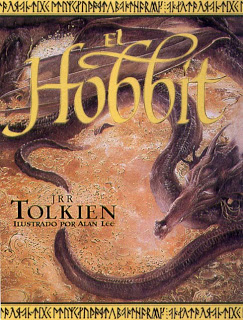 La Comarca
La Comarca
In Spanish, the Shire is known rather literally as a “region” or “province”. This name was translated out of necessity, for in Spanish the “sh” sound does not typically exist. Personally, I find this name lacking of the novelty of “Shire.”
Bolsón Cerrado
The Spanish name for “Bag End” is rather odd. We find Bilbo’s surname used to represent the “Bag” in his aforementioned smial, but where one expects to find “end” there is the Spanish “cerrado” (literally “closed”). I am at a loss as to how to properly account for his translation; I will note, however, that the name flows much better as translated than if any variant of “end” had been used instead.
Montañas Nubladas
I find the Spanish name for the Misty Mountains very descriptive. Of note here is “nubladas” (literally, “cloudy/overcast”, from “nube” cloud). While “misty” and “cloudy” both denote mystery, the Spanish name is particularly foreboding; the verb “nublar” means “to darken/to cloud” and has a negative and ominous connotation in Spanish. This is of course an apt warning of the Misty Mountains.
Lago Largo
The Spanish version of the “Long Lake” is very evocative of its English translation. Both exhibit an alliterative nature and are composed of two one-syllable words. This is, perhaps, exemplary of an ideal translation, if ever there were such a thing, as neither an ounce of meaning nor sound is lost.
————————————————————————————–
Next I present some Chinese translations of proper names.
Before continuing, however, I must note a few important characteristics of the Chinese language for those who have no experience with it. Unlike Spanish, Chinese is much more concerned with the preservation of sound. The Chinese have a long tradition of translating words such that they are phonetically similar to their native language-form. Here are two examples: first, the Chinese name for Germany is deguo (de, because of the German Deutschland, and guo meaning “country/nation”). While the character de has literal meaning (“virtues” or “ethics”), in this context it is used simply because it sounds like the “de” in Deutschland. Another example is the translation of the English name Michael; the Chinese form, maike, literally means something along the lines of “overcome wheat”. Yet, again, the Chinese in this instance forgo meaning in favor of sound. Thus, as you will see, the majority of translations involve preserving sound in Chinese. Yet looking at what potential literal translations of the names yield is a rather funny and interesting task.
 #1 (huo bi te ren)
#1 (huo bi te ren)
This is the Chinese form of “hobbit.” It can literally be translated as “quickly compare special people.” This name, oddly enough, recognizes one truth: the unique and special nature of hobbits. Whether conveyance of this meaning was intended or not by the translator, I am not sure, though.
#2 (gu lu mu)
As you might have guessed, this is Gollum in Chinese. The literal meaning of this name is very odd: it can be translated as “nanny guru.” It does imply Gollum is old (which is true) and beholding of some secret knowledge, as a guru is (also, perhaps, true).
#3 (zhong tu shi jie)
The Chinese name for Middle-earth is an example where meaning is carried over sound. It literally means “middle earth/soil world”. However, another translation of “zhong1 tu3” is “Sino-Turkish,” though, of course, that is not the intended meaning.
#4 (bierbo bajinsi)
This is Bilbo Baggins—and a very difficult name to translate, too. The first name cannot really be translated at all. However, the surname is quite interesting; one translation could be “long for gold” which, although perhaps not applicable to Bilbo himself, is a rather pertinent note on the story as a whole.
#5 (gan dao fu)
As it sounds, this is Gandalf. The translation I like most for his name is “willing path man,” for, as we know, Gandalf is an instinctive wanderer; they do call him The Grey Pilgrim, after all.
#6 (si mao ge)
Smaug’s name is also very apt for his character. I translate this name as “careless spear,” which reflects his wantonly destructive nature.
#7 (you an mi lin)
The Chinese form of Mirkwood is another rare instance where meaning is favored over sound. This name literally means “gloomy jungle.” The dark and ominous connotation of the Chinese form is, in my opinion, much more powerfully negative than even the original English.
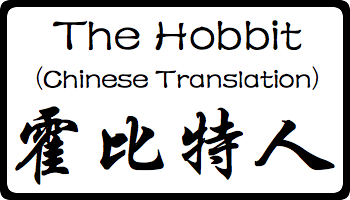 #8 (tuo er jin)
#8 (tuo er jin)
Lastly, I decided to include Tolkien’s Chinese name because it is oddly appropriate for the Professor. The name can be translated as “entrusting you with gold,” which I interpret in two ways: first, this can be seen as a reference to The One Ring, and, second, it can refer to Tolkien’s gift of his writings to us (his literary “gold,” if you will). Again, any intent on the part of the translator is impossible to know.
————————————————————————————
…. stay tuned for more from Tedoras ….
Join us every Tuesday for more engaging conversation with live chatters around the world who join our innovative broadcast TORn TUESDAY, featuring interviews with Tolkien/Fantasy luminaries, authors, and artists — many of whom are Ringer fans just like us! Every Tuesday at 5:00PM Pacific Time
If you have a Tolkien/Middle-earth inspired poem you’d like to share, then send it to poetry@theonering.net. One poem per person may be submitted each month. Please make sure to proofread your work before sending it in. TheOneRing.net is not responsible for poems posting with spelling or grammatical errors.
Posted in:
Share:

 iTech Post.com: Ancient humans that bear a resemblance to the fictional hobbit creatures apparently had bigger brains than we previously gave them credit for.
iTech Post.com: Ancient humans that bear a resemblance to the fictional hobbit creatures apparently had bigger brains than we previously gave them credit for.
The species known as Homo floresiensis was previously thought to have a brain volume of 400 cc, but it was actually 426 cc, bringing their brain size to roughly the same as a chimpanzee. That is, compared to about 1500 cc we currently have as Homo sapiens.
Researchers determined the larger brain size with a high-definition CT scanner.
The remnants of the “hobbits” were discovered on the island of Flores, part of Indonesia, in 2003.
The individuals were roughly three and a half feet tall, and had short legs when compared to their arms and feet.
[Read More]
Posted in:
Share:

 Welcome to our weekly live webcast — known as TORn TUESDAY — a unique show format where you can come into the chat and participate live. We are now on the 4th part of our ongoing series of discussions on the History of the Dwarves who undertake the Quest of Erebor. Today we switch gears to discuss OIN and GLOIN (father of our Fellowship member Gimli) and learn about the great fate tying up these characters in the House of Durin’s Line! Bring your questions and join us LIVE for what will be a very illuminating discussion of dark Dwarven secrets! We have *JUST* confirmed that our actors playing these roles have been whisked away to the studios in Wellington, where Peter Jackson has commenced new shoots for The Hobbit: The Desolation of Smaug!
Welcome to our weekly live webcast — known as TORn TUESDAY — a unique show format where you can come into the chat and participate live. We are now on the 4th part of our ongoing series of discussions on the History of the Dwarves who undertake the Quest of Erebor. Today we switch gears to discuss OIN and GLOIN (father of our Fellowship member Gimli) and learn about the great fate tying up these characters in the House of Durin’s Line! Bring your questions and join us LIVE for what will be a very illuminating discussion of dark Dwarven secrets! We have *JUST* confirmed that our actors playing these roles have been whisked away to the studios in Wellington, where Peter Jackson has commenced new shoots for The Hobbit: The Desolation of Smaug!









